|
BULB LOG 01 --- 4th January 2006
Now, as I start into the fourth year of what was to be a one year project, I have stopped worrying about repeating myself in the Bulb Log. Growing bulbs is a cyclical and repetitive process; however there are always new flowers, new challenges, new ideas, new problems and successes to report on. I thought I would start this year with a look in the various glasshouses that we have.
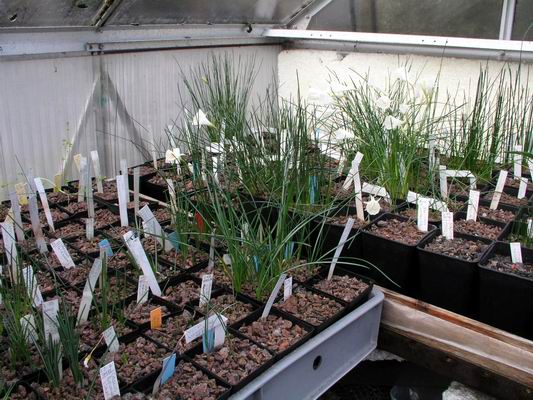
Gothenburg annex left
The bit that I call the Gothenburg annex is a small extension squeezed in between what used to be the propagation house and a stone shed. This is where we used to grow all our pleiones many years ago but it was taken over by bulbs raised from seed that we received from that haven for bulboholics, Gothenberg Botanic Garden. Now it houses is a mixture of bulbs from seedlings up to mature flowering bulbs in 7, 8, and 11 centimetre plastic pots - not all are from Gothenburg. To the left are the crocus and Narcissus, many of which are in flower or bud already. As they are sitting on a very shallow layer of sand, less than 2cms, which does not provide much of a reservoir, they can dry out quite quickly and I have to watch that they are receiving sufficient water.
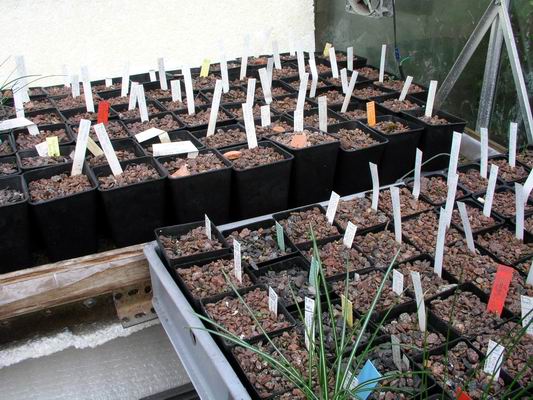
Gothenburg annex right
The right hand side of Gothenburg annex is mostly fritillaria, none of which are showing yet apart or the F. aggrestis I showed in last weeks log.
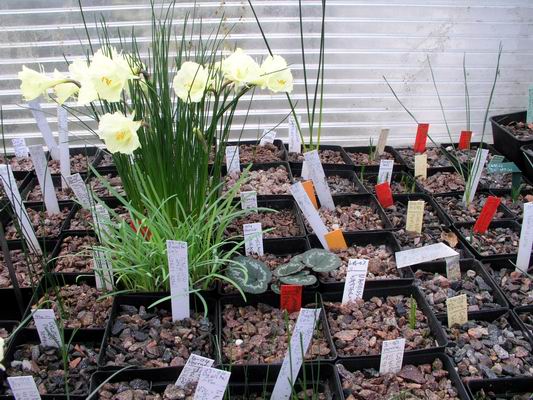
Mist plunge
Moving back into the propagation house, what was our mist unit has been taken over by 7 and 8 cm pots of bulbs. These are mostly seedlings but some, like the narcissus, are mature bulbs that have been selected and I am trialling them to see how they increase and how well they flower. It was a big decision to take to start to grow our plants in these small square plastic pots as we were used to growing massive round clay potfuls for the Show Benches, however I have no regrets as we can have as many as 10 square plastic pots in the space of a single large round clay pot. When I tell you that the Narcissus romieuxii selection in the picture is growing in an 8cm pot and it has 20 flowers we are in a win win situation with well flowered pots and many more forms, species and genera in the same space as we had before. Just in front of the narcissus is a pot of Ipheion seedlings.
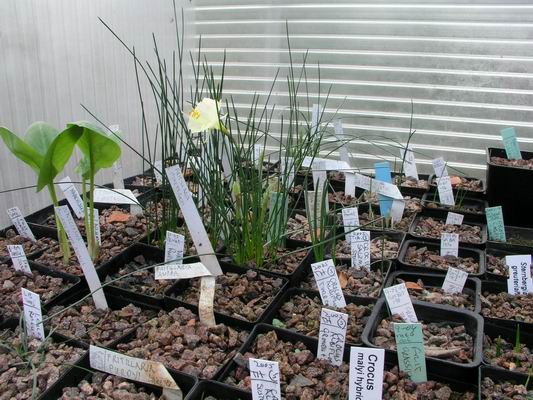
Mist plunge 2
Further along the mist plunge we have seedling Arums, crocus, tulips, fritillaries and more narcissus to name a few.
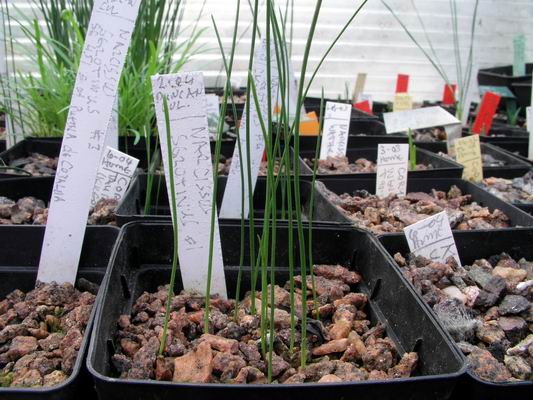
Narcissus serotinus seedlings
I am especially pleased to have a few pots of Narcissus serotinus seedlings from collected material. We have always struggled to repeat flower this autumn flowering species from bought in bulbs but I hope that now we have a good number of seed raised bulbs we will be able to select out good forms that will thrive and flower in our climate and growing conditions.
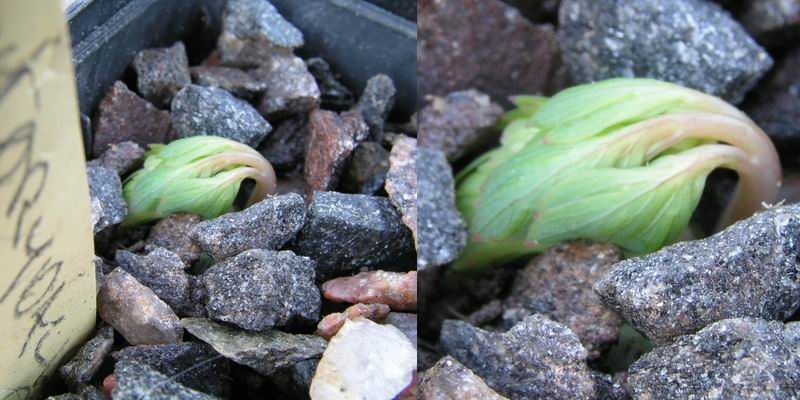
Corydalis paschei emerging
Also in this area this Corydalis paschei from our own second generation garden seed is just emerging.
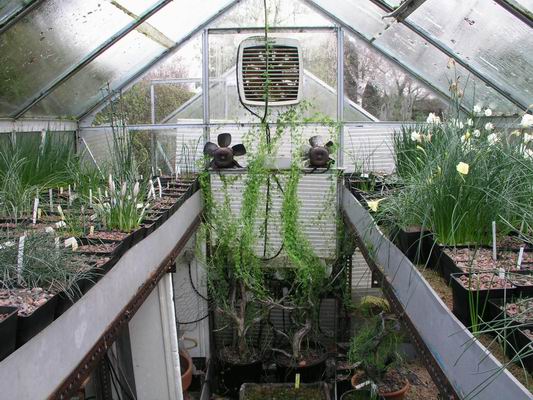
Bulb house
Now into the next glass house: the 'Bulb house': this used to be our alpine house but was gradually taken over by bulbs. All our alpines now grow outside in raised beds and troughs where many are still thriving without the need for glasshouse protection. (The third glasshouse can be seen behind this one, this is the frit house which I will look at next week.)
As you can see all the bulbs in the Bulb House are also growing in square plastic pots. Tropeolum tricolorum is slowly taking hold of the end of the glasshouse climbing its way up to the fans that we used more when we grew the cushion alpines. If you look on the right hand lower level you will see a round clay pot, this is our original P&W1989 plant of Tropaeolum azureum well into growth.
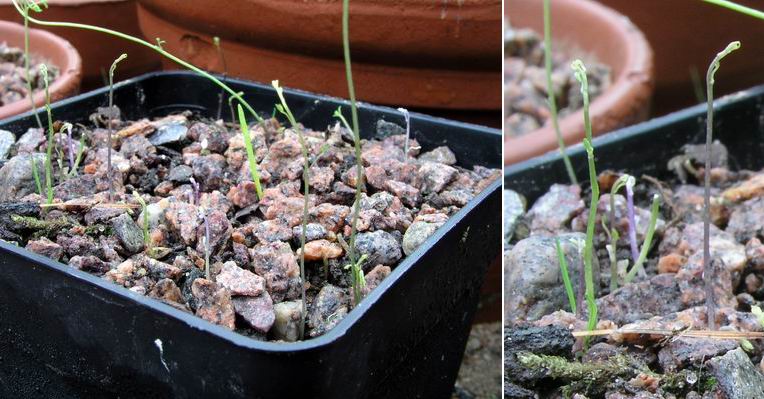
Tropaeolum azureum seedlings
I have always been mystified when it comes to germinating Tropaeolum azureum seed but this year I can report the best ever germination from our own seed, I have 3 13cm pots, each with many seed germinated like this one. It is interesting to see that some of them are a violet blue colour when they first emerge, while others are green, I wonder if there will be any noticeable difference in the mature plants. I sowed these seeds, as I always do, half way down the pot in September and left them outside to take the weather. The most observant of you may notice that some of the seedling stems have been cut back - this was done by slugs venturing out in some of the milder days for some fresh greens. This is not a problem as I always take the growing tip off of our Trop. azureum anyway to allow the side growths to grow, this produces a better plant - I learnt this technique from the slugs in the first place.
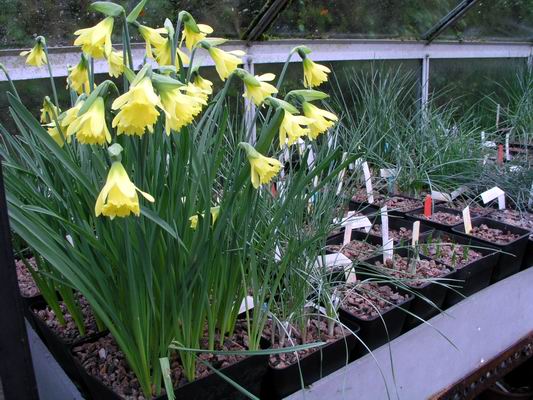
Bulb house left
The plunges in the bulb house are not laid out in any particular order; with genera or species all grouped together, they are mostly placed out in the order they were repotted. This random method does result in community groups so while the left hand side does contain a lot of Crocus and Fritillaria it also has a number of Narcissus like the prominent 'Cedric Morris'.
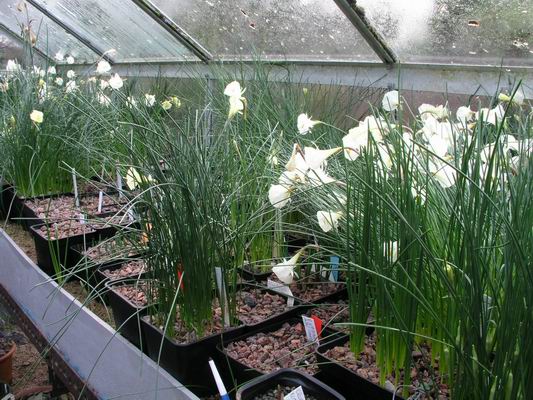
Bulb house right
The right hand side is dominated by Narcissus but also contains groups of pots of Crocus, Fritillaria etc. One of the downsides of having the pots so tightly packed is that the plants tend to get etiolated because they do not get the maximium amount of light; this is especially noticeable with the winter flowering Narcissus romieuxii.
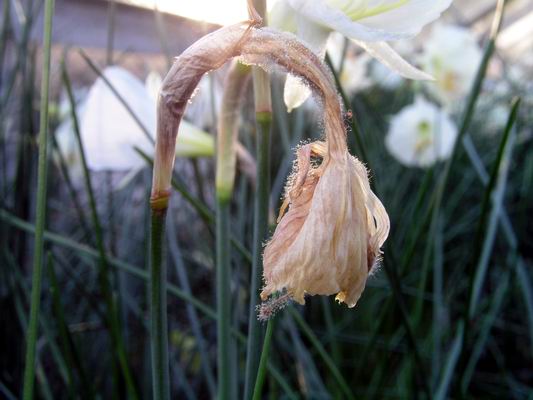
Mould on Narcissus flower
It is also essential to keep the ventilation to the maximium by having the doors and vents open whenever the temperature is not below freezing to help minimise the spread of moulds like botrytis which thrive in these cool damp conditions. With our swinging weather and especially the very damp days we can get through the winter, botrytis can quickly form on fading flowers. To prevent this spreading to the healthy leaves and stems of the plants the fading and affected flowers should be removed leaving the seed pod if it is not affected.
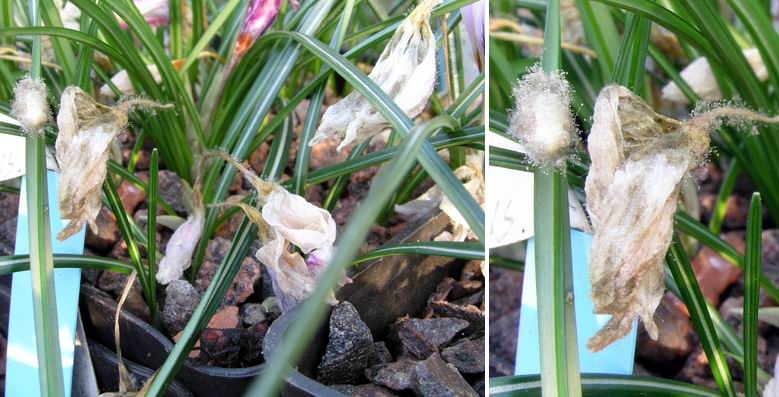
Mould on Crocus flower
The same is true for the spent crocus flowers which attract moisture like a sponge and should be plucked off the plant. This will not stop the plant setting seed as the crocus seed pods are still well under ground at this stage of growth - they only push up when the seed is ripe and ready to shed.
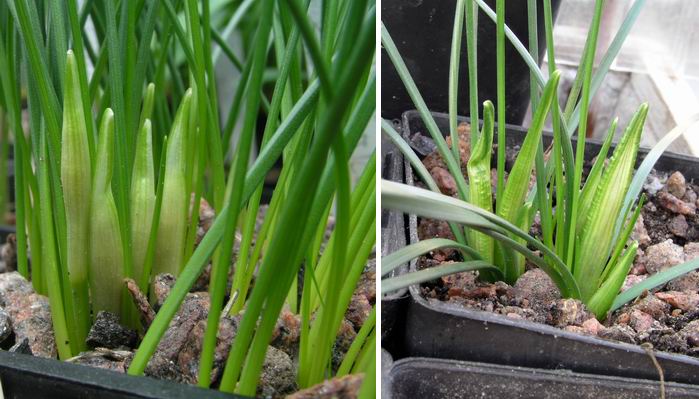
Narcissus buds x2
Despite having reduced the size of pots we grow I have not reduced my expectation of flower power. By careful feeding through the season I expect each bulb to perform to its best and produce a good display of flowers. To those of you that may be new to the log I will give details of my feeding regime as and when I am doing it.
^ back to the top ^
|

